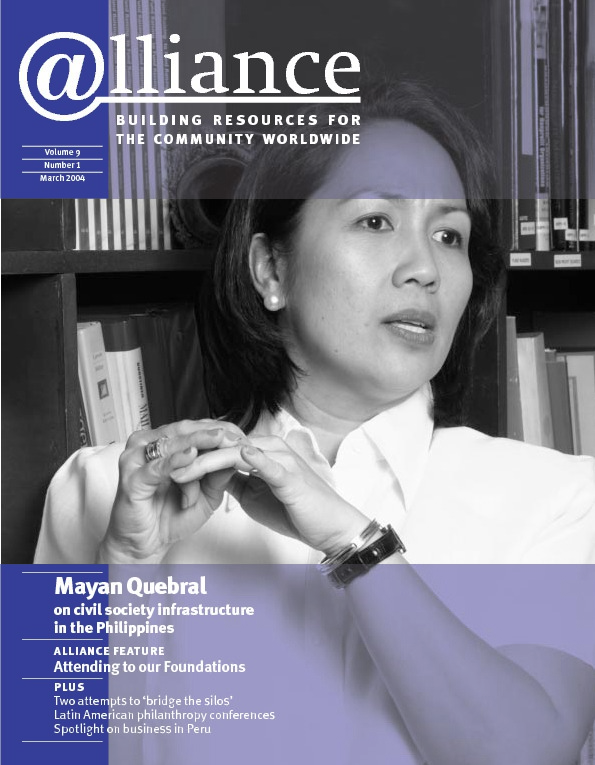Community foundations, originally a North American concept, constitute one of the fastest growing forms of organized philanthropy worldwide. A recent survey places their number at 1,175, with 30 per cent located in countries outside the US and Canada.[1] Moreover, they have begun to collaborate across national and cultural borders in order to share experience and expertise and to jointly develop new ideas, concepts and strategies.
The Transatlantic Community Foundation Network (TCFN), now just ending its second phase (2002-2005),[2] has been an important catalyst of the emerging international community foundation movement.
Created in 1999 by the Bertelsmann Stiftung with the support and advice of the C S Mott Foundation, TCFN is a focused learning organization comprising 46 community foundations and support organizations from 14 countries, almost equally balanced between Europe and North America. Members range from relatively new entities to foundations that have logged many years of service to their communities. The working groups which constitute the core of the network have developed a range of valuable tools and resource materials, which will all be available free on TCFN’s website.
Benefits for both sides of the Atlantic
Independent evaluation of the programme[3] shows that TCFN has directly assisted the European foundations in particular to become stronger and more viable. European participants cited specific changes foundations had made, ranging from the adoption of policies and procedures (eg development of new financial controls or conflict of interest policies) to the development of skills (eg media relations or board development). As one European participant argues, ‘[Without TCFN] we would not have developed as fast as we have. We benefit from learning from foundations all over the world, and we’ve skipped some stages. We are only six years old, but I feel experience-wise we are already 15 years old.’
At the same time – and contrary to the original assumption that European members would be the main beneficiaries – the evaluation suggests that Americans and Canadians in the network learned as much as the Europeans. ‘[For my foundation], the whole idea of transparency really came out of the TCFN, and the focus on civil society,’ one network member from the US reports. ‘That terminology I heard very infrequently in the community foundation realm – it was all about assets and dollars and donors, and not much on the other side. It’s terribly refreshing to really see the big reason why we’re involved in all of this.’
Three vital lessons
The lessons and insights of the network are presented in a new report, Building an International Learning Community, available from the TCFN website.[4] TCFN, it suggests, offers three vital lessons to anyone creating, supporting or participating in a learning community, particularly an international network:
The development of relationships is the most important objective. The most significant and lasting impact of TCFN may be the personal and professional relationships that have been forged. These are likely to last throughout participants’ careers and can be worth more than the knowledge exchanged during network meetings.
Linguistic and cultural differences should be leveraged, not overcome. International networks cannot afford to assume that linguistic and cultural issues will resolve themselves. Networks must dedicate resources and actively help participants learn to navigate and benefit from linguistic and cultural differences.
Timing is critical. TCFN was unquestionably a catalyst during the internationalization of the community foundation field, but certain elements had to be in place for the network to be viable. Probably most important, the maturity level on both sides of the Atlantic was right.
The report also outlines seven key steps relating both to the creation of a learning network. When launching a network, it suggests, it is important to set clear goals, choose the right mix of participants, assign the right topics, and keep groups an appropriate size. When nurturing and sustaining the network, it’s important to engage skilled facilitators, actively address language and culture, and conduct concurrent evaluation.
Creating and sustaining an international learning community requires a significant commitment of resources over a number of years. But, as the experience of TCFN shows, the difficulties are far outweighed by the potential benefits.
1 Eleanor W Sacks, 2005 Community Foundation Global Status Report, available at http://www.wingsweb.org
2 The Bertelsmann Stiftung and the Mott Foundation have renewed their commitment for a third phase, beginning in late 2005 and continuing into 2008.
3 The evaluation was conducted by Community Planning & Research, LLC. The report is available at http://www.tcfn.efc.be
4 The report was written by Robert H Martin, Diana Haigwood and Alan Pardini of Community Planning & Research, LLC, who had conducted two extensive evaluations of the TCFN.
Peter Walkenhorst is Director, Philanthropy & Foundations, at the Bertelsmann Stiftung. He can be contacted at peter.walkenhorst@bertelsmann.de
For more information about TCFN, visit http://www.tcfn.efc.be or contact tcfn@bertelsmann.de


Comments (0)